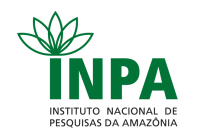Corpo Discente - Egressos
Alexandre Souto Santiago
| Título | DIVERSIDADE DE MACROINVERTEBRADOS BENTÔNICOS DE QUATRO IGARAPÉS DO PARQUE NACIONAL MONTANHAS DO TUMUCUMAQUE, ESTADO DO AMAPÁ, BRASIL | ||||||||||||||||||||||||
| Data da Defesa | 30/05/2018 | ||||||||||||||||||||||||
| Download | Em sigilo | ||||||||||||||||||||||||
Banca
| |||||||||||||||||||||||||
| Palavras-Chaves | Ecologia. Biomonitoramento. Grupos de Alimentação Funcional. | ||||||||||||||||||||||||
| Resumo | Os impactos ambientais causados por ações antrópicas tais como a retirada de cobertura vegetal, mineração, entre outras atividades, provocam alterações nos ecossistemas aquáticos, muitas vezes com consequências danosas para os ambientes e organismos. Na avaliação destes impactos devem ser considerados os fatores físicos e biológicos, pois os organismos vivos reagem ativamente às alterações infringidas ao ambiente. Objetivou-se avaliar a composição e organização das comunidades de macroinvertebrados bentônicos em igarapés do Parque Nacional Montanhas do Tumucumaque, no município de Serra do Navio, Estado do Amapá. Para tal, foram analisados os grupos tróficos funcionais. As coletas foram realizadas usando rede de arrasto ou de mão para a amostragem dos organismos aquáticos do sedimento e infauna associada dos trechos dos igarapés. As comunidades de macroinvertebrados bentônicos dos igarapés apresentam predominância de insetos, seguido por crustáceos e aracnídeos. O grupo trófico funcional dos filtradores foi o mais abundante, seguido dos predadores e detritívoros. A maior diversidade de macroinvertebrados bentônicos ocorreu no mês de outubro de 2014, mas a maior abundância foi nos meses de fevereiro e agosto de 2015. O nível das águas foi a principal variável ambiental influenciadora da estrutura destas comunidades de macroinvertebrados bentônicos. Conclui-se que os igarapés investigados estão bem preservados, devido à abundante e rica macrofauna bentônica. | ||||||||||||||||||||||||
| Abstract | The environmental impacts caused by anthropic actions such as the removal of vegetation cover, mining, among other activities, cause changes in aquatic ecosystems, often with harmful consequences for environments and organisms. In the evaluation of these impacts, physical and biological factors must be taken into account, since living organisms actively react to changes in the environment. The objective of this study was to evaluate the composition and organization of benthic macroinvertebrate communities in streams of the Tumucumaque Mountains National Park, in Serra do Navio, Amapá State. For this, the functional trophic groups were analyzed. The collections were carried out using trawl or hand net for the sampling of the aquatic organisms of the sediment and associated infauna of the streams of the streams. The benthic macroinvertebrate communities of the igarapés are predominant of insects, followed by crustaceans and arachnids. The functional trophic group of the filters was the most abundant, followed by predators and detritivores. The greatest diversity of benthic macroinvertebrates occurred in October 2014, but the greatest abundance was in the months of February and August of 2015. The water level was the main environmental variable influencing the structure of these communities of benthic macroinvertebrates. It is concluded that the igarapés investigated are well preserved due to the abundant and rich benthic macrofauna. | ||||||||||||||||||||||||
Parceiros

























